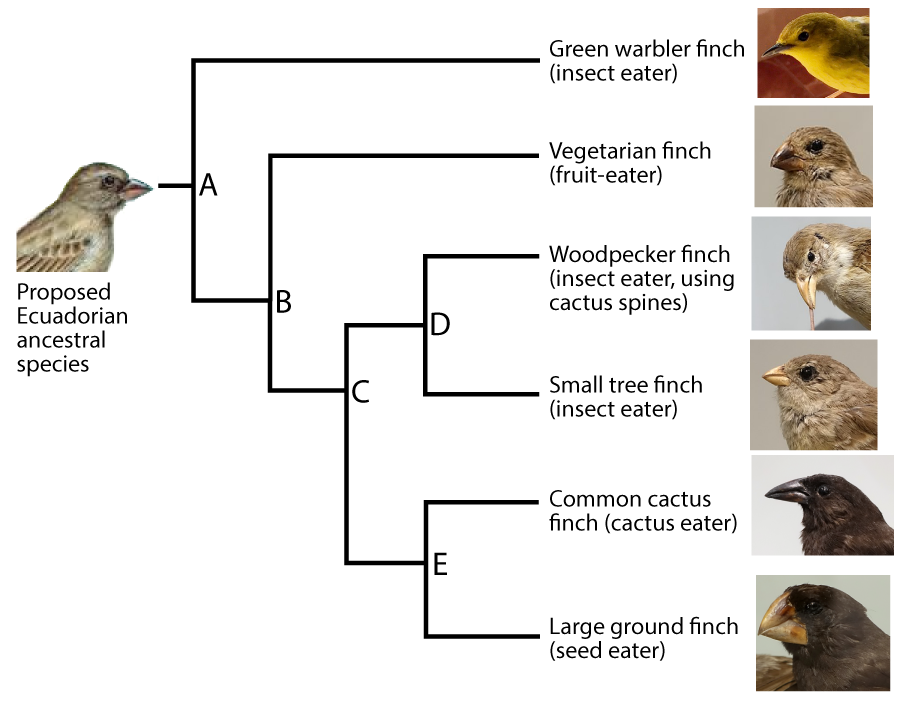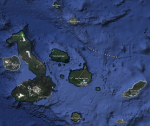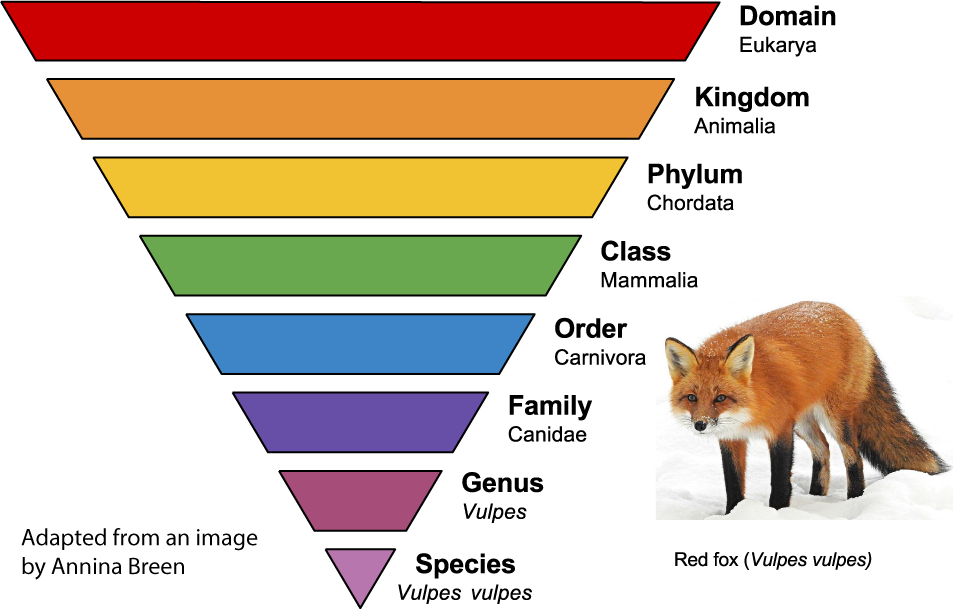1. Modern Taxonomy is about identifying clades
 The branching diagram shown to the left is called a phylogenetic tree. Phylogeny is the study of evolutionary history and relationships among individuals or populations.
The branching diagram shown to the left is called a phylogenetic tree. Phylogeny is the study of evolutionary history and relationships among individuals or populations.

The species shown in this phylogenetic tree are among the most famous in biology. They’re Galapagos Finches, first identified by Charles Darwin in the early 1800s. The Galapagos are a group of volcanic islands in the Pacific Ocean, about 1000 km (600 miles) west of Ecuador. It’s thought that a small population of birds from Ecuador colonized the islands, which then evolved over time into over a dozen species.
In a very compact format, phylogenetic trees accomplish two things.
- First, they tell the evolutionary history of a group of species. For example, a quick glance at the phylogenetic tree for the Galapagos Finches shows how one species (A) is the common ancestor of the entire group. A speciation event caused “A” to split into two major lineages or lines of descent. One lineage led to the Green Warbler finch. The other led to all the species that are descended from “B.”
- Second, phylogenetic trees show us the kind of nested, hierarchical groupings of species that we looked at in the last tutorial.
Identifying groups with a common ancestor is one of the most important moves in modern taxonomy. A clade is a group of organisms that includes a common ancestor and all of its descendants. A clade can be a group of species, a single species, or a population within a species.
Clades can be nested within clades. Knowing that, let’s do some analysis of this phylogenetic tree. Answer the question below.
[qwiz qrecord_id=”sciencemusicvideosmeister1961-How many clades?”]
[h]How many clades?
[q multiple_choice=”true”] How many clades are in this phylogenetic tree?
[c]IDEg[Qq][c]IDUg[Qq][c]IDYg[Qq][c]ID Ex
Cg==[Qq][f]IE5vLiBUaGVyZSYjODIxNztzIG9uZSBjb21tb24gYW5jZXN0b3IsIGJ1dCBtYW55IG1vcmUgY2xhZGVzLiBLZWVwIHJlYWRpbmcgYmVsb3cu[Qq]
[f]IE5vLiBUaGVyZSBhcmUgNSBicmFuY2ggcG9pbnRzLCBidXQgbWFueSBtb3JlIGNsYWRlcy4gS2VlcCByZWFkaW5nIGJlbG93Lg==[Qq]
[f]IE5vLiBUaGVyZSBhcmUgc2l4IGRlc2NlbmRhbnQgc3BlY2llcywgYnV0IG1hbnkgbW9yZSBjbGFkZXMuIEtlZXAgcmVhZGluZyBiZWxvdy4=[Qq]
[f]IE5pY2UhIFRoZXJlIGFyZSAxMSBjbGFkZXMuIEtlZXAgcmVhZGluZyBiZWxvdy4=[Qq]
[/qwiz]
To help you understand how clades work, I’ve redrawn the diagram below, and added shading so that the clades are easier to identify.
The clade that’s descended from species “A” is numbered as clade “1.” Because “A” is the common ancestor of all of the species shown in the diagram, clade 1 consists of all of the six species shown on the right, plus their common ancestor on the far left.

For any clade that consists of more than one species, the common ancestors are located at nodes. The nodes are labeled “A” through “E.” Because nodes are where speciation events occur, they’re also called branch points.
A speciation event at node “A” created two clades, “2” and “3.” A second speciation event at node “B” produced two more clades (“4” and “5.”). Another speciation event at “C” produced clades “6” and “7.” Speciations at nodes “D” and “E” produced additional clades, each consisting of a single species.
A big part of taxonomy involves identifying the clades that an organism belongs to. For example, the large ground finch is a member of 5 clades
- Its own species (the large ground finch)
- Clade 7
- Clade 5
- Clade 3, and
- Clade 1
Note that some clades are very specific, consisting of just one species. Others are more general. In the preceding example, the large ground finch clade is the most specific: it contains just one species. Clade 7 is slightly more general: it contains two species. Clade 3 contains 5 species.
 Let’s connect this to the hierarchical classification categories developed by Linnaeus. If classification is done correctly, then each taxon, within each category, should be a clade. That’s what we see in the example to the left.
Let’s connect this to the hierarchical classification categories developed by Linnaeus. If classification is done correctly, then each taxon, within each category, should be a clade. That’s what we see in the example to the left.
All of the foxes within the genus Vulpes are a clade. That clade excludes other members of the dog family (the Canidae) such as wolves. Canidae is a clade that contains all members of the dog family but excludes other carnivores. Similarly, the class Mammalia is a clade. All mammals, from kangaroos to whales, share a common ancestor. Other non-mammalian Chordates (such as fish) are not part of the clade.
Below, we’ll learn about how biologists identify clades. But before that, let’s consolidate what you read with some flashcards and a quiz.
2. Phylogeny and Phylogenetic Trees: Checking Understanding
2a. Flashcards
[qdeck qrecord_id=”sciencemusicvideosmeister1961-Phylogeny and Phylogenetic Trees FC”]
[h]Phylogeny and Phylogenetic Trees Flashcards
[q]Review from the last tutorial: The branch of biology concerned with classification is
[a]taxonomy
[q]A branching diagram like the one below is known as a _____________ ______.
[a]phylogenetic tree
[q]The study of evolutionary history and the relationships among individuals or populations is known as
[a]phylogeny
[q]A group that consists of a common ancestor and all of its descendants is a
[a]clade
[q]In the phylogenetic tree below, letters A, B, C, D, and E represent three things. What are they?
[a]
- The letters are branch points (where one species splits into two or more descendants).
- These branch points are also known as nodes.
- Finally, each node is where you find a clade’s common ancestors.
[q]A single line of descent (such as that from “p” to “r”) is known as a _______________.
[a]lineage
[q]If taxonomy is done correctly, then each taxon should be a _____________.
[a]clade
[/qdeck]
2b. Quiz
[qwiz qrecord_id=”sciencemusicvideosmeister1961-Phylogeny and Phylogenetic Trees Quiz (HS)”]
[h]Phylogeny and Phylogenetic Trees
[i]
[q] All of the Galapagos finches descend from a common ancestor. That makes the birds below a [hangman]
[c]IGNsYWRl[Qq]
[q] The study of evolutionary history is called [hangman]
[c]IHBoeWxvZ2VueQ==[Qq]
[q] The diagram below says that all bears make up a [hangman].
[c]IGNsYWRl[Qq]
[q] In the diagram below, the shaded rectangles represent _______________. The letters represent common _______________. They’re also called _______________. And because they represent points where one lineage splits into two, they’re also called _______________ points.
[l] ancestors
[fx] No, that’s not correct. Please try again.
[f*] Great!
[l] branch
[fx] No. Please try again.
[f*] Great!
[l] nodes
[fx] No, that’s not correct. Please try again.
[f*] Correct!
[l] clades
[fx] No, that’s not correct. Please try again.
[f*] Great!
[q] The common ancestor of clade 6 is
[textentry single_char=”true”]
[c]IE Q=[Qq]
[f]IE5pY2Ugam9iISAmIzgyMjA7RCYjODIyMTsgaXMgdGhlIGNvbW1vbiBhbmNlc3RvciBvZiBjbGFkZSA2Lg==[Qq]
[c]IEVudGVyIHdvcmQ=[Qq]
[c]ICo=[Qq]
[f]IE5vLiBIZXJlJiM4MjE3O3MgYSBoaW50OiBUaGUgY29tbW9uIGFuY2VzdG9yIG9mIGNsYWRlIDcgaXMgJiM4MjIwO0UuJiM4MjIxOyBJZiB0aGF0JiM4MjE3O3MgdGhlIGNhc2UsIHRoZW4gd2hhdCYjODIxNztzIHRoZSBjb21tb24gYW5jZXN0b3Igb2YgY2xhZGUgNj8=[Qq]
[q] “B” is the common ancestor of which clade?
[textentry single_char=”true”]
[c]ID M=[Qq]
[f]IFdheSB0byBnbyEgJiM4MjIwO0ImIzgyMjE7IGlzIHRoZSBjb21tb24gYW5jZXN0b3Igb2YgY2xhZGUgMy4=[Qq]
[c]IEVudGVyIHdvcmQ=[Qq]
[c]ICo=[Qq]
[f]IE5vLiBIZXJlJiM4MjE3O3MgYSBoaW50OiAmIzgyMjA7QyYjODIyMTsgaXMgdGhlIGNvbW1vbiBhbmNlc3RvciBvZiBjbGFkZSA1LiBJZiB0aGF0JiM4MjE3O3MgdGhlIGNhc2UsIHRoZW4gJiM4MjIwO0ImIzgyMjE7IGlzIHRoZSBjb21tb24gYW5jZXN0b3Igb2Ygd2hpY2ggY2xhZGU/[Qq]
[q multiple_choice=”true”] How many clades are in this phylogenetic tree?
[c]IDEg[Qq][c]IDUg[Qq][c]IDYg[Qq][c]ID Ex
Cg==[Qq][f]IE5vLiBUaGVyZSYjODIxNztzIG9uZSBjb21tb24gYW5jZXN0b3IsIGJ1dCBtYW55IG1vcmUgY2xhZGVzLg==[Qq]
[f]IE5vLiBUaGVyZSBhcmUgNSBicmFuY2ggcG9pbnRzLCBidXQgbWFueSBtb3JlIGNsYWRlcy4=[Qq]
[f]IE5vLiBUaGVyZSBhcmUgc2l4IGRlc2NlbmRhbnQgc3BlY2llcywgYnV0IG1hbnkgbW9yZSBjbGFkZXMu[Qq]
[f]IE5pY2UhIFRoZXJlIGFyZSAxMSBjbGFkZXMu[Qq]
[q] A diagram like the one shown below is a [hangman] tree.
[c]IHBoeWxvZ2VuZXRpYw==[Qq]
[f]IEdyZWF0IQ==[Qq]
[q] A line of descent from an ancestor to its descendants (which would include “p” through “r” below”) is known as a [hangman].
[c]IGxpbmVhZ2U=[Qq]
[f]IEdyZWF0IQ==[Qq]
[q] In the diagram below, “A” is the [hangman] [hangman] of all of the other species in this phylogenetic tree.
[c]IGNvbW1vbg==[Qq]
[f]IEdyZWF0IQ==[Qq]
[c]IGFuY2VzdG9y[Qq]
[f]IEdyZWF0IQ==[Qq]
[q]Letters “A,” “B,” and “C” can also be thought of as [hangman] points. They’re also called [hangman]. These are points where [hangman] events occurred.
[c]YnJhbmNo[Qq]
[c]bm9kZXM=[Qq]
[c]c3BlY2lhdGlvbg==[Qq]
[/qwiz]
Links
- Continue to Clades and Phylogenetic Trees, Part 2 (the next tutorial in this module)
- Classification and Phylogenetic Trees (HS Level) Main Menu
